<< New Q&A More Q&A, Part 15 >> Part 14
>> 13 >> 12
>> 11 >> 10
>> 9 >> 8
>> 7 >> 6
>> 5 >> 4
>> 3 >> 2 >>
1 >> Gunwriters
guns.connect.fi Link page

Custom Search
Latest update 28.10.2001
G.O.W. Kickback:
Questions and Answers
Part 16. Answered by: P. T. Kekkonen
 MORE
ABOUT DREYSE PISTOL
MORE
ABOUT DREYSE PISTOL
Thank you for answering my inquiry. I am going to attach pictures
to this and the following e-mail so that you can at least look at it. I am aware that
without physically holding it you would not be able to give me an exact value, but with
the picture would you be able to approximate a value. In you previous e-mail you stated
that interest for this type of pistol was high in Germany and on the Western side of a big
pool. Where is this? Again, Thank you for all the help you have given.
Jean.
Congratulations! You possess a gem! The Dreyse revolver (SIC! Not a pistol) on
the pictures is a rare collector's item even if it is a plain product, but your revolver
is a De Luxe version with handmade engravings, and the condition seems to be very fine.
Value of plain gun in good condition is about USD 5.000, but you may add at least thousand
"bucks" more, because of existence of original engravings and stamps. Even the
manufacturer's logo and "charge stamp" are clearly visible.
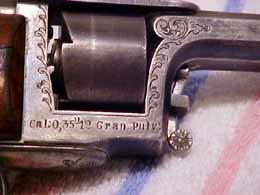
Charge weight "GRAN PULVER" means really "gran of powder", not gram or
grains. (Gran was an old Prussian weight unit, used by pharmacists/ druggists for weighing
doses of very strong drugs like morphine, aconitine or white arsenic). The Dreyse revolver
is really designed by FRANZ von DREYSE in 1850. I don't know, whether it shot paper-cased
cartridges, the "rocket bullets" or both of them, but it was a needle-fire
handgun with a primer on the bullet base (cavity?), ignited with a needle-like firing pin
thrusted through a powder charge by a long stroke of a striker. French LeFAUCHEUX pinfire
revolvers were soon overwhelming competitors of Dreyse revolver.
First pinfire pistols were introduced in the Chrystal Palace Exhibition (London, 1851).
They were designed by CASIMIR LeFAUCHEUX. Most of them were single-shot break-loader
duelling pistols with a mechanism similar to a LeFaucheux shotgun. Just one was a
six-barreled "pepperbox pistol" shooting, however, metal cartridges. Dreyse
revolver was also introduced, but it was unable to attract any notice. "Battle
proven" percussion revolvers of SAMUEL COLT and big double-action-only wheelguns of
ROBERT ADAMS were just gaining popularity in 1851. EUGENE LeFAUCHEUX (son of Casimir?),
get idea to combine mechanism of Colt "Navy" Model 1851 to the metal cartridges
designed by his father and gunsmith HOULLIER, along with "triple action" trigger
mechanism of Adams & BEAUMONT. This mechanism allowed cocking of the hammer with a
thumb like hammer of Colt revolvers or simply by pull of the trigger like
"bobbed" hammer of original Adams revolver.
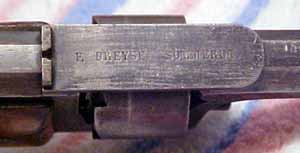
Eugene LeFaucheux became a manager of his father's manufacture soon after Chrystal Palace
Exhibition. Revolvers with just single barrel and six-shot cylinder, breechloaders,
shooting all-metal cartridges, were adopted for mass-production in 1853. It continued
until 1930s. Pinfire revolvers had never the power of heavy percussion revolvers, but they
were cheap. Mass-produced cartridges were also inexpensive. Dreyse revolvers disappeared
from production sometimes in mid-1850s. I presume that less than thousand of them were
ever made. They lacked power for military use or even for self-defence (although ANY gun
is better for self-defence or home protection than NO gun at all).
For target practice there were available single-shot Dreyse pistols and a large selection
of handguns made by other manufactures in Prussia and other Continental European
countries. Franz von Dreyse designed also another model of revolvers, with a very
futuristic loading mechanism: Cylinder and barrel could be swung to right side of the
frame for reloading. My available literature is, unfortunately, unable to tell when the
2nd model Dreyse revolver was designed and whether it shot metallic cartridges or still
the "rocket bullets", if not cartridges with paper cases, ignited with a
"needle sting". Presumably just a handful of these revolver prototypes were ever
made.
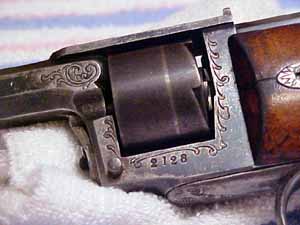
Swinging cylinder was adopted in 1892 for French military revolver (incorrectly called as
"LEBEL revolver"). It's cylinder swings also to the right side (= WRONG side) of
the frame, but the barrel stays fastened to the frame. It is impossible to say, whether or
not construction of French revolver M:le 1892 was copied from original idea of Franz
von Dreyse.
PS: The "Big Pool" is pet-name of the Atlantic Ocean. In Finnish it is "Rapakko"
(= pool, puddle or a mud hole). Finnish emigrants and sailors "seilasivat Rapakon
taakse", when they sailed to American continent already hundred years ago, but that
very term is still in commonplace use here.
1110 MMI; PT
DUMOULIN RIFLE, A TREASURE!
I recently picked up a gun at a local gun show in Nebraska, USA. The gun first appeared to
be a commercial F.N. Mauser. It looked like the original bolt shroud had been removed and
an aftermarket trigger had been installed. The action has the typical Mauser extractor
with no thumb slot for a stripper clip. The gun has all the right proof marks for export
from the European market. The barrel has 3 names on it and "Made in Belgium"
stamped on it. The names stamped in the barrel are 1) H. Dumoulin 2) Milmorte-Liége
3) B. Blindée.
I was wondering if you might have any knowledeg of these manufacturers. The stock is a
pretty decent piece of walnut with 22 lines/inch checkering. The blueing is pretty light
with many bare metal parts showing through. I run a custom gun shop and was wondering if I
should re-blue and re-finish the stock or leave it alone. I own several commercial Mausers
but have never seen one like this. Any information or thoughts would be greatly
appreciated.
Thanks, Terry (USA).
Manufacturer of your rifle is H. DUMOULIN; a well-known Belgian manufacture of
high-quality firearms, usually shotguns. Milmorte-Liége is an address of Dumoulin
plant; suburb of town Liége, the firearms industry center of Belgium. In another
suburb, Herstal, are the plants of Fabrique National (F.N.) company. Actually all the
firearms made in Belgium went via this town for proof. Stamp B. BLINDÉE (Balles
Blindée; French) means: "(for) jacketed bullets". Your Dumoulin rifle is
made purposely for hunting. It is not a sporterized & re-barreled military Mauser. And
it hasn't been an inexpensive purchase to it's first owner.
A walnut stock is presumably not lacquered but impregnated with linseed oil. Re-finishing
of it may be done by washing with a dilute solution of some detergent. (In Finland is
popular the dish washer powder. Contains about 75 % sodium hydroxide - Caustic Soda.
Really efficient). Rinse the stock with hot water after washing and let it dry in the room
temperature. Takes day or two. If needed, brush the checkering grooves open with a
toothbrush. Then rub the linseed oil with the palm of hand on the stock. Let it to become
absorbed into the wood. Repeat rubbing until wood take up no more oil. Apply also some
linseed oil into gutters of barrel and receiver of the stock and to the mortises of
magazine, trigger mechanism, recoil lug and tang of receiver. Let the oil to dry in warm
place some days or a week. Polish - if needed - the stock with a nylon stocking or
leotards crosswise to the direction of wood fibres.
There are not too many gunsmithing shops able to carry out the "Lege Artis"
blueing of metal parts with original "browning & bluing" method. Most
gunsmiths (and manufactures) prefers the puffing the gun parts and cooking them in some
alkaline sodium nitrate solution, which stains the steel glossy black. This method is
actually not BLUEING; it is BLACKENING. Yess; the puffed and blackened metal parts are
beautiful, but so re-blued surface is not done "by the Rules of Art".
Preferably, let the steel parts to be as they are!
Definitely, do not use any "cold blue" chemicals for re-blueing of steel. They
may render the metal surface to look like a steel blued with "rust blueing"
method, looking good when lubricated, but this color is far from permanent. It is not a
lasting ferric oxydule skin, but just the iron stained with selenium acid. I call almost
all of the cold blueing chemicals as "Bottled Treachery". Sole exception is
"PLUM BROWN BARREL FINISH" of BIRCHWOOD CASEY, but it is (or was) a browning
chemical, which stain the iron or steel brown, and it must be applied on the heated steel;
not on the cool metal.
Your rifle is more valuable than you could imagine when you bought it. Don't do or let
anybody do anything which may lessen the value of your original Dumoulin.
1110 MMI; PT
"PjERVIY ROTA -
PLI..!"
I have been shooting the old Berdan II rifle for a while, with mixed sucess. My best
results have been using .348 Winchester cases that have been fire-formed, about 70 grains
of FFG, and a beeswax over-powder wad. I use a 365 gr. lead bullet from a custom mold that
closely duplicates the original paper patched bullet. Of course, it does require me to
paper patch, too, but this has not been too difficult...
I have not chronographed the load, but I believe that it closely duplicates the original
military load - and, the rifle shoots to point-of-aim with the issue sights at 100m.
Anyway, my question is this: What kind of accuracy should I expect from a Berdan? I have
been getting about 4 - 5 MOA with this loading at 100 m. Do you have any suggestions for
improving the load, the lube, the powder? Certainly Finland must be the only place in the
world with any group of experienced shooters of Berdan rifles, and I would welcome any
ideas you might have.
The Berdan I have been using was made in 1882 in Ishevsk, and is in very good condition.
The trigger pull is a bit stiff at 2.7 kg.; any suggestions on improving the trigger pull
and/or accurizing the rifle would be helpful, too.
For what it is worth, before having the custom mold commisioned, I experimented with
several off-the-shelf commercial lead .44 caliber bullets, but with poor results--perhaps
this was a result of my relative inexperience shooting black powder, and a lack of any
loading data .
I got the loading for the military cartridge by using old military rifle reference books,
and taking apart a few old rounds. My apologies for lacking enough Finnish to ask these
questions properly.
Kiitoksia paljon, Dave
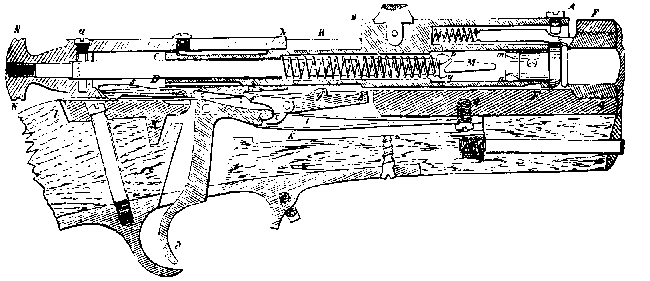
Your
load with the custom-made mould cast bullet seems to be about correct. Original BERDAN
rifle load had a bullet weight 25 grams (presumably excluding weight of the "talikuppi";
a cardboard cup between powder charge and bullet's base inside the case neck), id est: 386
grains. Bullet was 99% pure lead with 1% of antimony; a rather soft alloy. Don't cast your
bullets from too hard lead alloy like Linotype! Powder charge in old Russian units of
weight was one and three sixteenth solotnik; 5.0 grams or 77 grains for rifle cartridges.
Carbine cartridge was charged with 4.5 grams of powder; id est 69.4 grains of black
powder. Machine gun cartridges were loaded in England with some kind of
"semi-smokeless" powder; charge weight is unknown to me.
There were GATLING ("GORLOFF"), GARDNER and NORDENFELD-PALMCRANZ machine guns in
use, chambered for 4.2-lineynaya Berdan cartridges, and some of the very first
MAXIM guns bought for trials. Color codes of cartridges were: Rifle cartridge = white
paper patch. Carbine load = "salmon pink" patch, and machine gun cartridge =
"pigeon blue" patch (greyish blue). MG cartridges had also usually British
(Woolwich or Ludlow) headstamps. All kinds of cartridges had similar bullets, but there
were "winter ammo" and "summer ammo", at least for the rifles.
Difference was hidden inside the case neck: "Summer cartridges" had pure beeswax
wadding behind a bullet.

Photo: Short Berdan Dragonskyi Karabin.
"Winter cartridges" had wadding of tallow & beeswax mixture. There was just
a cardboard disc between the wadding and powder charge. Tallow & wax mixture could
melt in the hot weather and deteriorate the powder charge. During or soon after the Russo
- Turkish War (1877 - 78) was invented and adopted the tallow cup and mixture with a
tallow was adopted for use in all of the cartridges, despite of season. Pure beeswax gave
insufficient bore lubrication in cold weather. Hardened wax layer in the bore could also
tear away the paper jacket of bullets and cause accumulation of lead fouling in the bore;
especially in machine guns. Idea of a "tallow cup" might be imported from
England along with the machine gun cartridges.
Your load seems to be somewhat lighter than the original carbine load, which was preferred
also in the rifles especially for shooting competitions. 4 - 5 MOA is very satisfactory
accuracy of Berdan II (Model 1871) with cast bullets. Usual dispersion of five shots to
100 meters is one MIL (a thousands of shooting range) or 100 millimeters between centers
of most apart bullet holes with the swaged bullets; slightly less than 4 inches.
("Out-of-the-box" RUGER MINI-14 shoots about similar groups).
No other trick but improvement of the trigger pull is seemingly needed. Remove the stock
about annually and apply some linseed oil into the gutters of barrel and receiver, and
into the mortise of a recoil lug (a projection of receiver just behind the trigger) plus
on the surface of the stock, which leans on the receiver tang. This is all the
"bedding" your rifle needs.
Trigger pull improvement may be done by grinding the trigger spring somewhat narrower.
There are actually two springs fastened with same screw. Trigger spring is long one,
shorter flat spring is a sear spring. You may grind (carefully) the trigger spring
somewhat thinner or narrower. (Your choice!). The sear spring you may grind somewhat
shorter; a couple of millimeters, no more. If you can remove the sear, you may polish the
upper limb's point with a fine Arkansas stone. Polishing of that surface, where the end of
(shortened) sear spring leans on the sear and the surface of a trigger, where the end of
trigger spring leans makes the pull of trigger smooth. Don't overdo any of these steps!
Let the competent gunsmith to carry out this work, if you have not experience on
"fine tuning" of trigger mechanisms. Spare springs and other parts of Berdan may
be hard to get nowadays. DO NOT TRY TO "STRAIGHTEN" THE LEAF SPRINGS!
Recommended trigger pull is no less than 1.2 kilogram. 1.5 kg or 3 lbs is O.K.
In Finland we have really many owners of Berdan II rifles (issued for Home Troops during
Winter War 1939 - 40; removed, along with their cartridges, from Army inventory not until
1955). In early 1980s Berdans were popular for blackpowder shooting, but Remington Rolling Block rifles (caliber 12.17 x 44R Norwegian
& Swedish, centerfire) became still more beloved "shootable charcoal
burners". Straight cases of them were easy to make by lathe-turning. Many Swedish
rifles were unused and therefore somewhat more accurate than battered Berdans captured
from Finnish Red Guards during our Independence/Civil War in 1918. (I also had a Swedish
Remington rifle, but I was constrained to sell it away a couple of months ago, because of
my stringent financial situation: Eviction from our home and exitus by my own hand were
very nigh. No foreign visitors has paid their "debt of honour" since July).
The cast bullets are inherently less accurate than swaged ones. More than a decade ago I
designed the set of "BILLINGHURST Swage" with a cast mould of for the lead
cylinders and the heavy swaging tool for shaping them to similar shape than the original
Berdan bullets; including the base cavity, of course. Swage is designed to function with
some hits of a heavy hammer, and the extraction of swaged bullets was by hydraulic
pressure. Four sets of swages were produced for Berdan bullets. I don't know, whether the
swaged bullets (with paper jackets and wax mixture waddings, of course) are more accurate
than the cast ones, but they are at least free from any voids and uniform in size, shape
and weight. They are, of course, much more accurate than factory-made .44 caliber lead
revolver bullets which are too fat and too light for Berdan cartridges, as you told.
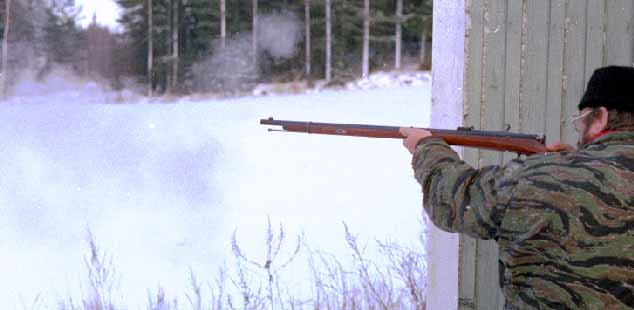
"Pyerviy rota - Pli!" A 60 year old original
cartridge ignited humbly when a successor of Cossacks fired his rare Dragonskyi Berdan.
This is a different model from the still shorter very rare Berdan Dragonskyi Karabin.
"Uh, it kicked like... like a Berdan!" Photo from GOW archives.
PS. A headline "Pyerviy rota - Pli!" means: "Front row -
Fire!" A command in archaic Russian for a platoon of riflemen in three rows.
Frontmost "rota" was prone, second row kneeling and rearmost was
standing.
Archaic Finnish word "talikuppi" means simply "a tallow cup".
Paper patches were impregnated with mixture of mutton or bovine tallow (1 part by weight)
and beeswax (2 or 2½ parts). This same mixture was also adopted for wads of "winter
bullets" and after adoptment of tallow cup for all bullets.
0110 MMI; PT
BÖHLERSTAHL AND NEUHAUSEN
Congratulations for you web site, I must indeed say that it is a most interesting site for
those firearms enthusiasts. I would like to make you a couple inquiries regarding two
rifles that were recently given to me.
1.- The first one is a large caliber (or so it seems to me) rifle. The marking it has is
Böhlerstahl, this marking is on the top of the gun. On the left side of the gun the
following markings can be found: 2.67 9GBP St. M.G. This rifle is a bolt action with
double trigger (hair trigger).
2.- The second one is quite an old rifle. This one only has a marking on the rear part of
the bolt action mechanism that says "Fab. D'Arms Neuhausen". This one is a
straight pull bolt action (it looks like a military rifle to me). On the right side it has
a lever (I believe this is for the safety and to disarm the gun) with three letters in the
following manner
L
A R
The rifle has a square magazine box for approximately 7 bullets (at least seven 30-06
bullets fit in) Through the muzzle nothing greater than a .22 bullet may fit, however it
seems that the cartridge itself is quite large. The total length of the gun is 1.22 mts.
(48.5 in) Total length of the barrel is 77.7 cms. (30.5 in) The sights marks up to 2000 (I
guess it is meters) and it is set on 400 (again I guess meters).
I hope the above information is enough for you as to help me determine the caliber and
possible age of this gun. Regards and thanks in advance.
José.
-1: "BÖHLERSTAHL"
stamp means that the barrel is of Böhler Steel. It is stamped also on the barrels of
Finnish military rifles Mosin-Nagant Model 1891/-24 or so-called "Lotta-Rifles".
Barrels were finished by German factories VENUS Waffenfabrik Oscar Will, Zella Mehlis
and RÖMERWERK A.G. Altogether 18.000 barrels of Böhlerstahl were made in
Germany. Name "Lotta-Rifle" means not that the rifles were issued to
women's association of Finnish Civil Guard, but this Lotta Svärd Association
acquired all the money needed for re-barreling of 25.500 Model 91/24 rifles. Stocks and
actions were salvaged from Russian Mosin - Nagants Model 1891 (also made in France and
USA: Receivers made by WESTINGHOUSE and REMINGTON were most sought-after for
Lotta-Rifles).
If your gun has no other stamps than "Böhlerstahl" and the mandatory
proof stamps, it is a custom made hunting rifle, presumably made in Germany by some
private gunsmith. "2.67 g G.B.P. St. M.G." means that the gun is proof-shot with
2.67 grams charge of flaked military rifle powder (Gewehr Blättchen Pulver) and
with a steel jacketed bullet (Stahl-Mantel Geschoss). In German proof-marks was
usually stamped the weight of proof-shooting bullet, but this very proof-mark may be
stamped before year 1913 - or actually 1912 - when the supplementary caliber markings were
adopted to general use, along with the stamp "NITRO" on the firearms proofed for
use of smokeless powder (especially shotguns). These supplementary marks were not
mandatory by German Proof Mark System of 1891 - 1939, if the rifle was custom made for
individual person; not mass-produced for wholesale and retail sales by sporting good
stores, or made for export.
-2: NEUHAUSEN (S.I.G.) is also a well-known firm to Finns as a manufacturer of 7.500
Lotta-Rifle barrels, and ca. 1.500 BERGMANN MP 18.I submachine guns (made by S.I.G.) were
also bought to Finnish Civil Guard in 1920s and 30s. Your Neuhausen gun is re-barreled (or
lined) Swiss SCHMIDT-RUBIN military rifle with straight-pull bolt action, presumably Model
1911, because it is seemingly chambered for high-pressure cartridges. Sights with a 2000
meters graduation are original. If the barrel (bore) is lined or "Pallisered" to
small caliber, the action is Model 1911. It's original barrel length is 777 millimeters.
Original caliber was 7.5 mm Swiss, shooting bullets with .308" diameter (7.83
millimeters), but depth of original rifling was designed for metal-jacketed bullets - NOT
for the paper-jacketed projectiles like American .30/.308 inch (7.62 mm/ 7.83 mm) rifling.
Cartridge of your gun may be a "wildcat"; a 7.5 mm Swiss case necked-down to
hold a 5.7 mm bullet. "Pallisering" of the bore means drilling and reaming of
the bore and shrinking or expanding a rifled barrel liner into it. Method is christened
after a Briton Sir WILLIAM PALLISER, who designed it to give "another life" for
cast iron or bronze barreled old smoothbore artillery pieces. A rifled wrought iron liner
was forced into the reamed cannon bore and expanded with a heavy proof-shooting load. Many
artillery pieces were pallisered in USA and CSA during the Independence War of American
Confederate States. Method was discovered in 1864. With similar "putkitus"
(lining) method were repaired also thousands of corroded 7.62 mm Mosin-Nagant rifle
barrels in mid-1920s in Finland.
Because your another rifle is seemingly also custom made, I am unable to estimate it's age
and caliber. Definitely it shoots not any of the usual military cartridges. If you start
shooting, don't cram seven cartridges into the magazine. It is designed for six
cartridges. Seventh may be, however, be pushed into the magazine deep enough for feed into
the rifle chamber.
Please Note: A correct term is CARTRIDGE (in Spanish CARTUCHO). The BULLET (in
Spanish BALA) is just the projectile; that loose part of cartridge which is propelled
through the bore towards a target.
0110 MMI; PT
More Q&A >>
<< New Q&A More Q&A, Part 15 >> Part 14
>> 13 >> 12
>> 11 >> 10
>> 9 >> 8
>> 7 >> 6
>> 5 >> 4
>> 3 >> 2 >>
1 >> Gunwriters
guns.connect.fi Link page